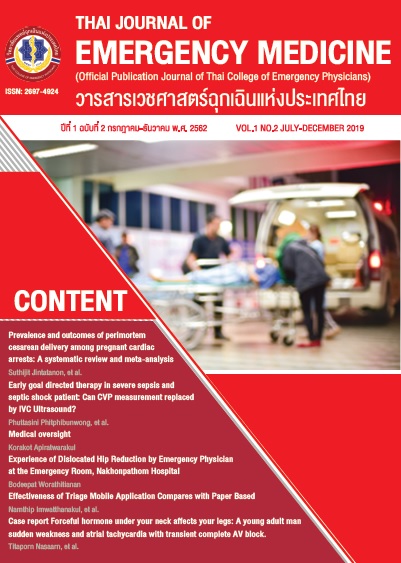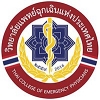Early goal directed therapy in severe sepsis and septic shock patient: Can CVP measurement replaced by IVC Ultrasound?
Keywords:
severe sepsis, septic shock, UltrasoundAbstract
Introduction : Previous studies in other countries comparing treatment of severe sepsis or septic shock according to early goal-directed therapy (EGDT) protocol to usual care yielded no difference in 90-day mortality. Nevertheless, the information on the method of fluid assessment in these studies was not provided. Also, there are currently no similar studies according to Thailand's emergency patients' context, which have different technology and equipment.
Objectives : To compare in-hospital mortality rate between patients diagnosed with severe sepsis or septic shock receiving non-invasive fluid assessment by non-invasive ultrasonography protocol to those receiving invasive central venous pressure measurement.
Methods : Retrospective cohort technique was used in this study, comparing emergency patients in Maharaj Nakorn Chiang Mai hospital with severe sepsis or septic shock treated according to EGDT protocol with fluid assessment using invasive central venous pres-sure measurement and those using non-invasive ultrasonography protocol. The primary outcome of the study was in-hospital mortality rate. The secondary outcomes were length of hospital stay and complications.
Results : During the data collection period from February to October 2015, there were 87 patients diagnosed with severe sepsis or septic shock admitted to inpatient departments. 79 patients were included into the study. 49 patients were treated according to EGDT protocol, while 30 patients were treated by non-invasive ultrasonography protocol. There were no significant differences between the two groups in term of in-hospital mortality rate, length of hospital stays, and no complications were found.
Conclusion : In hospital mortality rate in patients diagnosed with severe sepsis or septic shock were not significantly different between patients receiving non-invasive fluid assessment by non-invasive ultrasonography protocol and those receiving invasive central venous pressure measurement.
References
Rezende E, Junior JMS, Isola AM, Campos EV, Amendola CP, Almeida SL. Epidemiology of Severe Sepsis in the Emergency Department and Difficulties in the Initial Assistance. Clinics. 2008;63(4):457–64.
Mayr FB, Yende S, Angus DC. Epidemiology of severe sepsis. Virulence. 2014;5(1):4–11.
Kaukonen K-M, Bailey M, Suzuki S, Pilcher D, Bellomo R. Mortality related to severe sepsis and septic shock among critically ill patients in Australia and New Zealand, 2000-2012. JAMA. 2014;311(13):1308–16.
Dellinger RP, Levy MM, Carlet JM, Bion J, Parker MM, Jaeschke R, et al. Surviving Sepsis Campaign: international guidelines for management of severe sepsis and septic shock: 2008. Crit Care Med. 2008;36(1):296–327.
Dellinger RP, Levy MM, Rhodes A, Annane D, Gerlach H, Opal SM, et al. Surviving sepsis campaign: international guidelines for management of severe sepsis and septic shock: 2012. Crit Care Med. 2013;41(2):580–637.
Hp L, Ty L, Yw L, Wh L, Sk T. Delayed airway obstruction secondary to inadvertent arterial puncture during percutaneous central venous cannulation. Acta Anaesthesiol Sin. 2001;39(2):93–6.
Jr D, Ms C, Cm Z. [Central venous catheterrelated infections in critically ill patients]. Rev Assoc Medica Bras 1992. 1995;42(4):205–14.
Crowley AL, Peterson GE, Benjamin DK, Rimmer SH, Todd C, Cabell CH, et al. Venous thrombosis in patients with short- and long-term central venous catheter–associated Staphylococcus aureus bacteremia*: Crit Care Med. 2008;36(2):385–90.
Vinson DR, Ballard DW, Hance LG, Stevenson MD, Clague VA, Rauchwerger AS, et al. Pneumothorax is a rare complication of thoracic central venous catheterization in community EDs. Am J Emerg Med. 2015;33(1):60–6.
Barbier C, Loubières Y, Schmit C, Hayon J, Ricôme J-L, Jardin F, et al. Respiratory changes in inferior vena cava diameter are helpful in predicting fluid responsiveness in ventilated septic patients. Intensive Care Med. 2004;30(9):1740–6.
Cannesson M, Besnard C, Durand PG, Bohé J, Jacques D. Relation between respiratory variations in pulse oximetry plethysmographic waveform amplitude and arterial pulse pressure in ventilated patients. Crit Care. 2005;9(5):R562.
Lilly CM. The ProCESS trial--a new era of sepsis management. N Engl J Med. 2014;370(18):1750–1.
Goal-Directed Resuscitation for Patients with Early Septic Shock. N Engl J Med. 2014;371(16):1496–506.
Feissel M, Michard F, Faller J-P, Teboul J-L. The respiratory variation in inferior vena cava diameter as a guide to fluid therapy. Intensive Care Med. 2004;30(9):1834–7.
Rivers E, Nguyen B, Havstad S, Ressler J, Muzzin A, Knoblich B, et al. Early Goal-Directed Therapy in the Treatment of Severe Sepsis and Septic Shock. N Engl J Med. 2001;345(19):1368–77.
Brennan JM, Blair JE, Goonewardena S, Ronan A, Shah D, Vasaiwala S, et al. Reappraisal of the Use of Inferior Vena Cava for Estimating Right Atrial Pressure. J Am Soc Echocardiogr. 2007;20(7):857–61.

Downloads
Published
How to Cite
Issue
Section
License
บทความที่ได้รับตีพิมพ์ในวารสารเวชศาสตร์ฉุกเฉินแห่งประเทศไทย ถือเป็นเป็นลิขสิทธิ์ของ วิทยาลัยแพทย์เวชศาสตร์ฉุกเฉินแห่งประเทศไทย
กรณีที่บทความได้รับการตีพิมพ์ในวารสารเวชศาสตร์ฉุกเฉินแห่งประเทศไทยแล้ว จะตีพิมพ์ในรูปแบบอิเล็กทรอนิกส์ ไม่มีสำเนาการพิมพ์ภายหลังหนังสือเผยแพร่เรียบร้อยแล้ว ผู้นิพนธ์ไม่สามารถนำบทความดังกล่าวไปนำเสนอหรือตีพิมพ์ในรูปแบบใดๆ ที่อื่นได้ หากมิได้รับคำอนุญาตจากวารสารเวชศาสตร์ฉุกเฉินแห่งประเทศไทย



